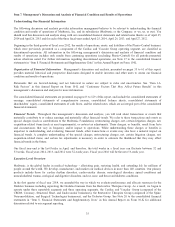Medtronic 2014 Annual Report Download - page 33
Download and view the complete annual report
Please find page 33 of the 2014 Medtronic annual report below. You can navigate through the pages in the report by either clicking on the pages listed below, or by using the keyword search tool below to find specific information within the annual report.medical device makers in the form of a 2.3 percent excise tax on all U.S. medical device sales that commenced in January 2013.
Under the legislation, the total cost to the medical device industry is expected to be approximately $20 billion over 10 years. We
expect the new tax will materially and adversely affect our business, cash flows and results of operations. The law also focuses
on a number of Medicare provisions aimed at improving quality and decreasing costs. It is uncertain at this point what negative
unintended consequences these provisions will have on patient access to new technologies. The Medicare provisions include
value-based payment programs, increased funding of comparative effectiveness research, reduced hospital payments for
avoidable readmissions and hospital acquired conditions, and pilot programs to evaluate alternative payment methodologies that
promote care coordination (such as bundled physician and hospital payments). Additionally, the law includes a reduction in the
annual rate of inflation for Medicare payments to hospitals that began in 2011 and the establishment of an independent payment
advisory board to recommend ways of reducing the rate of growth in Medicare spending. We cannot predict what health care
programs and regulations will be ultimately implemented at the federal or state level, or the effect of any future legislation or
regulation. However, any changes that lower reimbursement for our products or reduce medical procedure volumes could
adversely affect our business and results of operations.
Our self-insurance program may not be adequate to cover future losses.
We have elected to self-insure most of our insurable risks. We made this decision based on conditions in the insurance
marketplace that have led to increasingly higher levels of self-insurance retentions, increasing numbers of coverage limitations,
and dramatically higher insurance premium rates. We maintain a directors and officers policy providing limited coverage and
continue to monitor the insurance marketplace to evaluate the value to us of obtaining insurance coverage for other categories of
losses in the future. While based on historical loss trends we believe that our self-insurance program accruals and our existing
insurance coverage will be adequate to cover future losses, we cannot guarantee that this will remain true. Historical trends may
not be indicative of future losses. The fact that we do not maintain third-party insurance coverage for all categories of losses
increases our exposure to unanticipated claims and these losses could have a material adverse impact on our consolidated
earnings, financial condition, and/or cash flows.
If we experience decreasing prices for our goods and services and we are unable to reduce our expenses, our results of
operations will suffer.
We may experience decreasing prices for our goods and services due to pricing pressure experienced by our customers from
managed care organizations and other third-party payers, increased market power of our customers as the medical device
industry consolidates, and increased competition among medical engineering and manufacturing services providers. If the prices
for our goods and services decrease and we are unable to reduce our expenses, our results of operations will be adversely
affected.
Continuing worldwide economic instability, including challenges faced by the Eurozone countries, could adversely affect our
revenues, financial condition or results of operations.
Since fiscal year 2008, the global economy has been impacted by the sequential effects of an ongoing global financial crisis.
This global financial crisis, including the European sovereign debt crisis, has caused extreme disruption in the financial markets,
including severely diminished liquidity and credit availability. There can be no assurance that there will not be further
deterioration in the global economy. Our customers and vendors may experience financial difficulties or be unable to borrow
money to fund their operations which may adversely impact their ability to purchase our products or to pay for our products on a
timely basis, if at all. As with our customers and vendors, these economic conditions make it more difficult for us to accurately
forecast and plan our future business activities. In addition, a significant amount of our trade receivables are with national health
care systems in many countries (including, but not limited to, Greece, Ireland, Portugal, and Spain). Repayment of these
receivables is dependent upon the financial stability of the economies of those countries.
In light of these global economic fluctuations, we continue to monitor the creditworthiness of customers located outside the U.S.
Failure to receive payment of all or a significant portion of these receivables could adversely affect our results of operations.
Further, there are concerns for the overall stability and suitability of the Euro as a single currency, given the economic and
political challenges facing individual Eurozone countries. Continuing deterioration in the creditworthiness of the Eurozone
countries, the withdrawal of one or more member countries from the EU, or the failure of the Euro as a common European
currency could adversely affect our revenues, financial condition or results of operations.
25
























